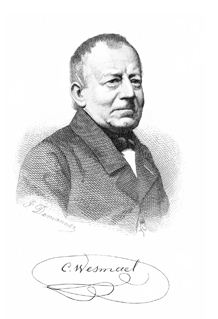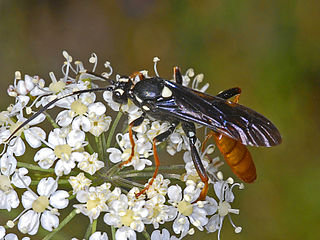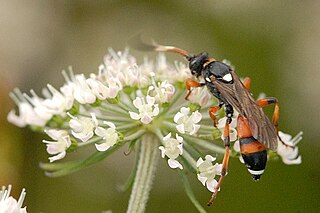
A mongoose is a small terrestrial carnivorous mammal belonging to the family Herpestidae. This family is currently split into two subfamilies, the Herpestinae and the Mungotinae. The Herpestinae comprises 23 living species that are native to southern Europe, Africa and Asia, whereas the Mungotinae comprises 11 species native to Africa. The Herpestidae originated about 21.8 ± 3.6 million years ago in the Early Miocene and genetically diverged into two main genetic lineages between 19.1 and 18.5 ± 3.5 million years ago.

The superfamily Ichneumonoidea contains one extinct and three extant families, including the two largest families within Hymenoptera: Ichneumonidae and Braconidae. The group is thought to contain as many as 100,000 species, many of which have not yet been described. Like other parasitoid wasps, they were long placed in the "Parasitica", variously considered as an infraorder or an unranked clade, now known to be paraphyletic.

The Ichneumonidae, also known as the ichneumon wasps or ichneumonids, is a parasitoid wasp family within the insect order Hymenoptera. This insect family is among the most species-rich branches of the tree of life. At the same time, it is one of the groups for which our knowledge most severely lags behind their actual diversity. The roughly 25,000 species described today probably represent less than a quarter of their true richness, but reliable estimates are lacking, as is much of the most basic knowledge about their ecology, distribution and evolution. Ichneumonid wasps, with very few exceptions, attack the immature stages of holometabolous insects and spiders, eventually killing their hosts. They thus fulfill an important role as regulators of insect populations, both in natural and semi-natural systems, making them promising agents for biological control.

Constantin Wesmael was a Belgian entomologist.

The Egyptian mongoose, also known as ichneumon, is a mongoose species native to the Iberian Peninsula, coastal regions along the Mediterranean Sea between North Africa and Turkey, tropical and subtropical grasslands, savannas, and shrublands in Africa. Because of its widespread occurrence, it is listed as Least Concern on the IUCN Red List.

The Indian grey mongoose is a mongoose species native to the Indian subcontinent and West Asia. It is listed as Least Concern on the IUCN Red List. The grey mongoose inhabits open forests, scrublands and cultivated fields, often close to human habitation. It lives in burrows, hedgerows and thickets, among groves of trees, and takes shelter under rocks or bushes and even in drains. It is very bold and inquisitive but wary, seldom venturing far from cover. It climbs very well. Usually found singly or in pairs. It preys on rodents, snakes, birds’ eggs and hatchlings, lizards and variety of invertebrates. Along the Chambal River it occasionally feeds on gharial eggs. It breeds throughout the year.

The white-tailed mongoose is a species in the mongoose family (Herpestidae). It is the only member of the genus Ichneumia.
The supposed American Elm cultivar Ulmus americana 'Pyramidata' was a Belgian clone listed by Wesmael in Bulletin de la Fédération des sociétés d'horticulture de Belgique, 1862, as Ulmus Americana pyramidalisHort.. It was marketed by the Baudriller nursery, Angers, France, and appeared in their catalogue of 1880 as U. Americana pyramidata. Wesmael's Ulmus americana and Ulmus americana var. variegata, however, do not appear from herbarium specimens to have been American white elm. It is known that nurseries in Europe and America marketed the golden wych elm Ulmus glabra 'Lutescens' as Ulmus americana aurea, so it is possible that Wesmael's Ulmus americana pyramidalis was similarly misnamed.
The so-called American Elm cultivar Ulmus americana 'Variegata' was a Belgian clone mentioned by Wesmael in Bulletin de la Fédération des sociétés d'horticulture de Belgique, 1862, as Ulmus americana var. variegataHort. It was marketed by the Baudriller nursery of Angers as U. americana foliis variegatis. Wesmael's herbarium specimens, however, held in the Botanic Garden, Meise, both of his Ulmus americana and of his Ulmus americana var. variegata, do not appear to show American white elm leaves. It is known that nurseries in Europe and America marketed the golden wych elm Ulmus glabra 'Lutescens' as Ulmus americana aurea, and it is likely that Wesmael's Ulmus americana variegata was similarly misnamed, and perhaps derived from a reverting branch of aurea, whose leaves it resembled.

Herpestes is a genus within the mongoose family Herpestidae. It is the type genus of the family and comprises ten living species, with several subspecies. Fossil remains of three prehistoric species were excavated in France and described in 1853.

Ichneumoninae is a worldwide subfamily of the parasitic wasp family Ichneumonidae.
Checklist of UK recorded Ichneumonidae. In this checklist are presented all wasp species of family Ichneumonidae.

Orius insidiosus, common name the insidious flower bug, is a species of minute pirate bug, a predatory insect in the order Hemiptera. They are considered beneficial, as they feed on small pest arthropods and their eggs. They are mass-reared for use in the biological control of thrips.
In the 10th edition of Systema Naturae, Carl Linnaeus classified the arthropods, including insects, arachnids and crustaceans, among his class "Insecta". Insects with membranous wings, including bees, wasps and ants were brought together under the name Hymenoptera.

Virgichneumon maculicauda is a species belonging to the family Ichneumonidae subfamily Ichneumoninae.

Ichneumon is a genus of parasitic wasps in the family Ichneumonidae.

Amblyteles armatorius is a species of parasitic wasp in the family Ichneumonidae first described by Johann Reinhold Forster in 1771.

Amblyjoppa fuscipennis is a species of the parasitic wasp in the family Ichneumonidae. It was first described by Constantin Wesmael in 1844.

Ichneumon sarcitorius is a species of wasp belonging to the family Ichneumonidae subfamily Ichneumoninae.
The Field Elm cultivar Ulmus minor 'Viminalis Incisa' was listed and described by John Frederick Wood, F.H.S., in The Midland Florist and Suburban Horticulturist (1851), along with what he called U. Viminalis and U. Viminalis Variegata, as U. Viminalis Incisa, the Cut-leaved Twiggy-branched elm. An Ulmus campestris var. nuda subvar. incisaHort.Vilv. was described by Wesmael in 1863, and considered by Green (1964) to be possibly one of Melville's U. × viminalis.















